Sourdough Marble Rye Bread
Sourdough Marble Rye Bread has beautiful swirls of light and dark sourdough bread. This loaf has great flavor and a moist crumb thanks to a generous helping of rye starter.
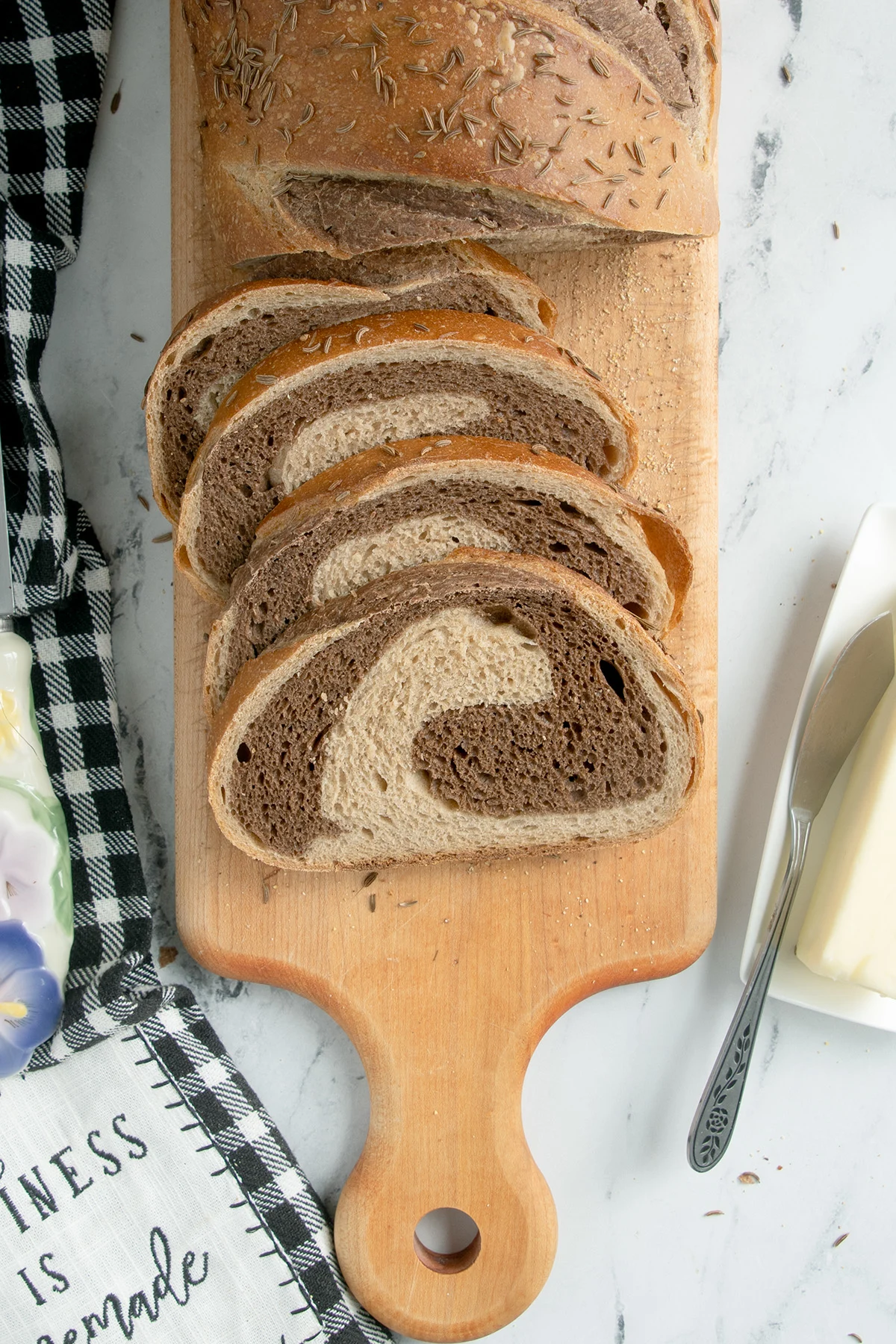
Sourdough Marble Rye Bread combines two great breads into one. You get a swirl of light Sourdough Rye Bread and a swirl of Sourdough Pumpernickel Bread. I’m a huge fan of rye bread in just about any form and I’m especially smitten with this recipe.
If you want fresh bread for lunchtime, start the night before and your bread is half way done when you get out of bed. That overnight rest is not only good for you, it’s also really good for the taste and texture of your bread.
If you don’t have a Sourdough Starter you might want to try the recipe for yeasted Marble Rye Bread.
Ingredients
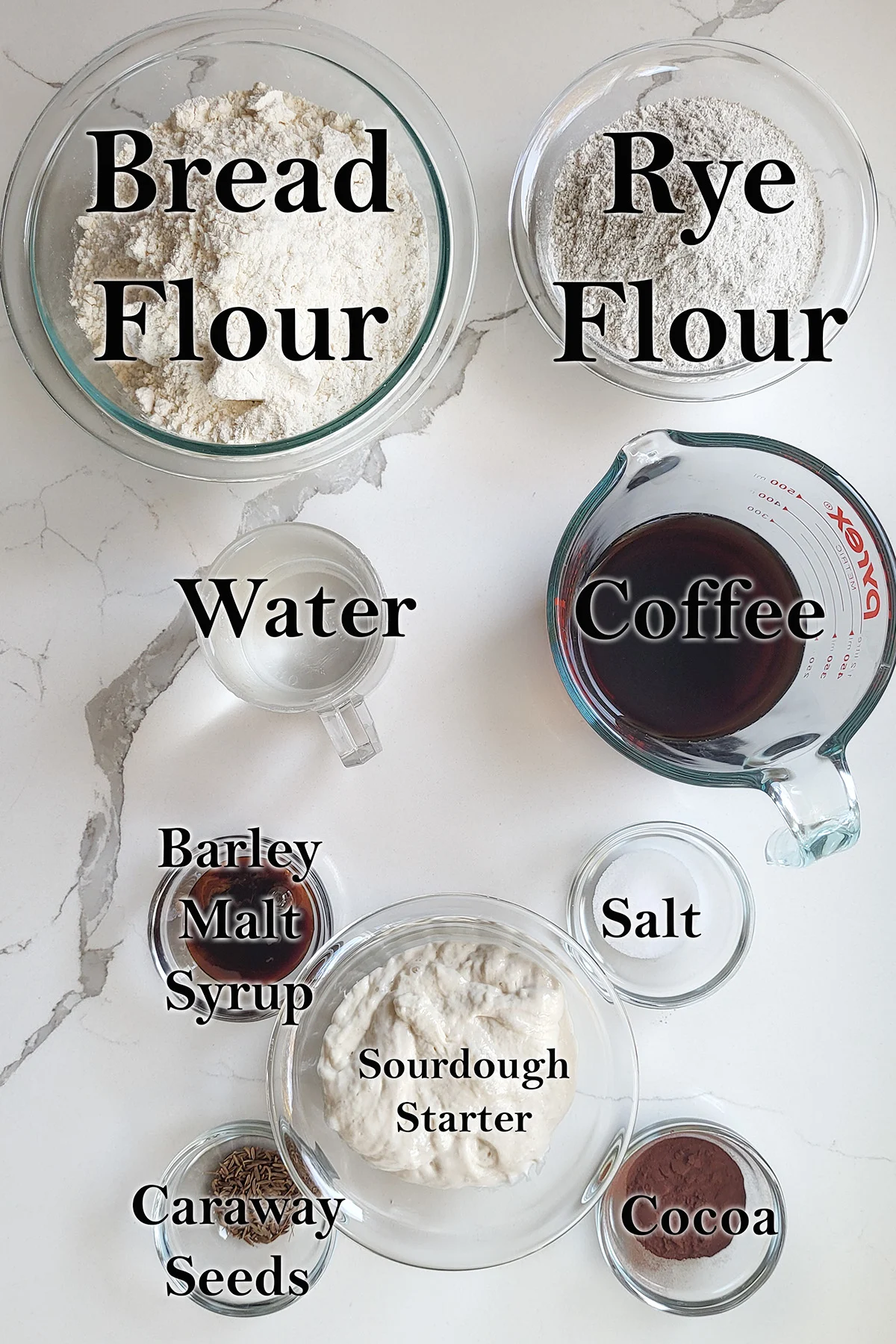
Ingredient Notes
- Rye Flour does not have the gluten forming properties of wheat flour. Use any type of rye flour in this recipe, light, medium or whole grain. Stone ground rye flour has an especially nice flavor and texture.
- Bread Flour is a wheat flour with a high protein content. Higher protein means better gluten development.
- Sourdough Starter The recipe was developed using 100% hydration starter. You will need to adjust the liquid or flour in the recipe if you’re starter isn’t at 100% hydration.
- Barley Malt Syrup adds a bitter-sweet note which works very well with the flavor of rye flour. You can substitute honey or a combination or honey and molasses for the barley malt syrup.
- Caraway Seeds add the characteristic “rye bread” flavor, but they are optional.
How to make Sourdough Marble Rye Bread
See the recipe card for detailed measurements and instructions.
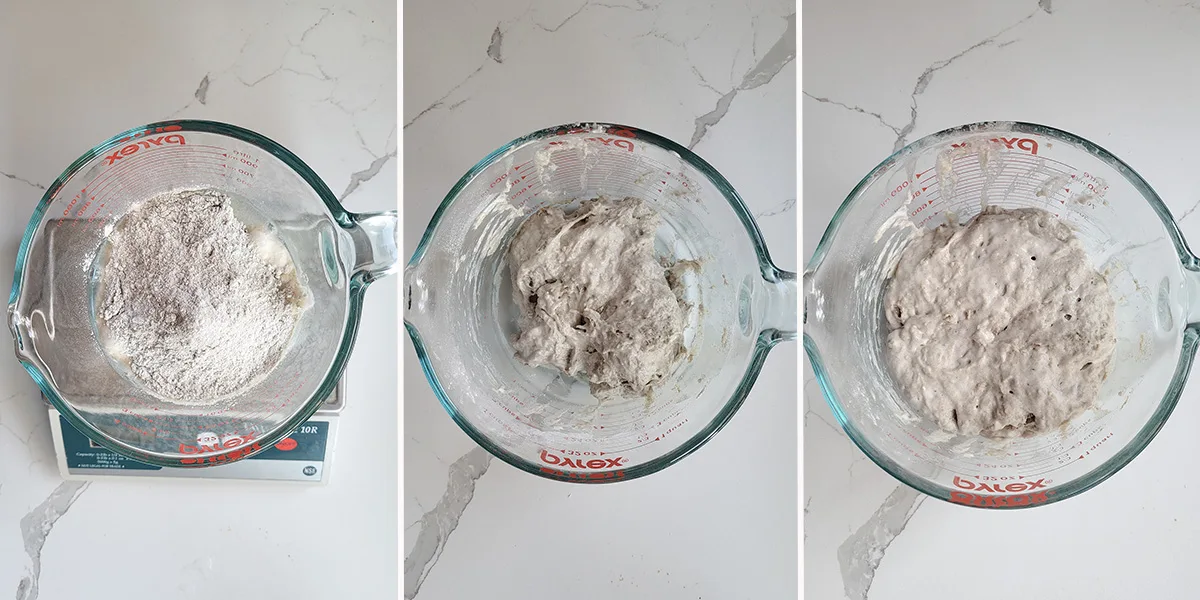
- Start with an unfed 100% hydration sourdough starter. Feed it with rye flour and water.
- Set the starter aside for 3-4 hours.
- Once the rye starter is at it’s peak you’re ready to mix the doughs.
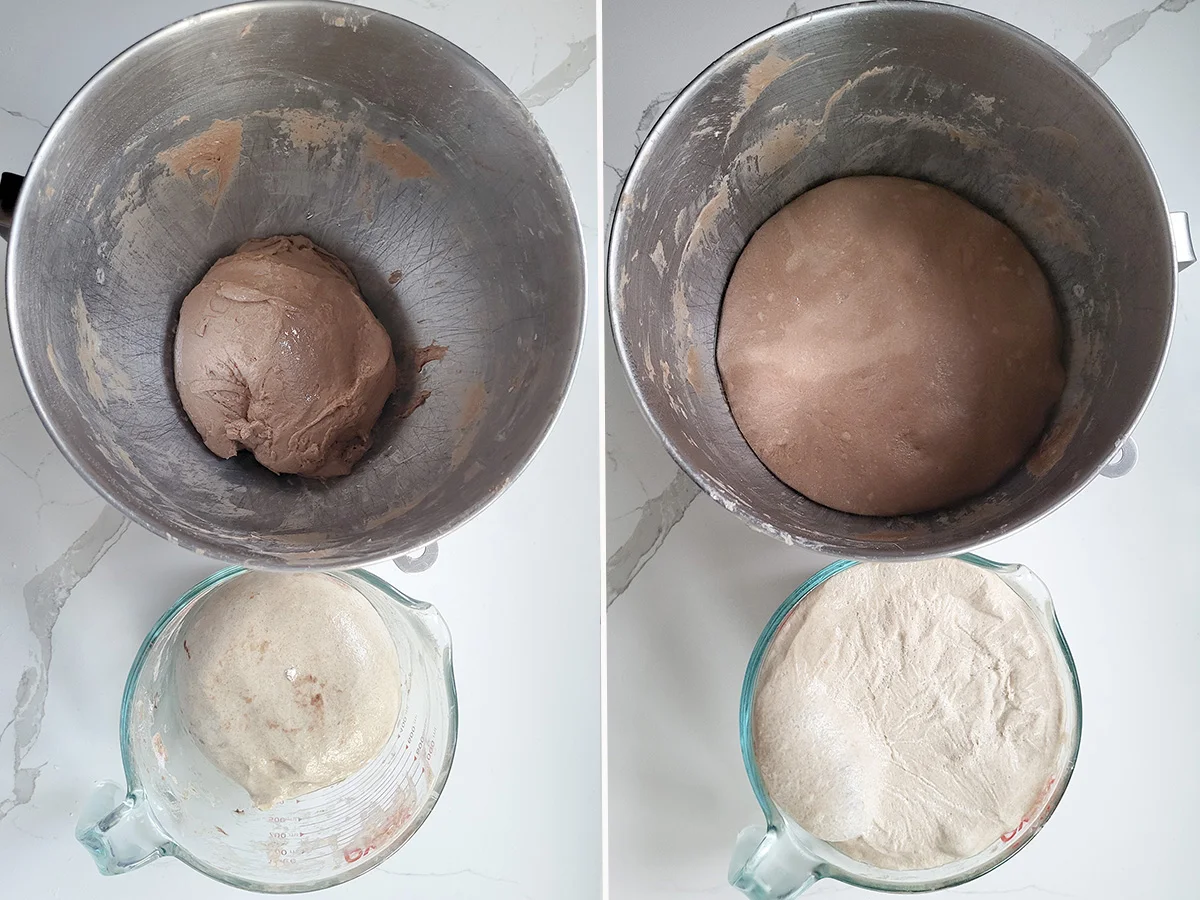
- Mix both the light and dark doughs and set them aside to ferment for 3-4 hours.
- After the initial fermentation your can shape and bake the loaf or you can put the dough into the refrigerator overnight.
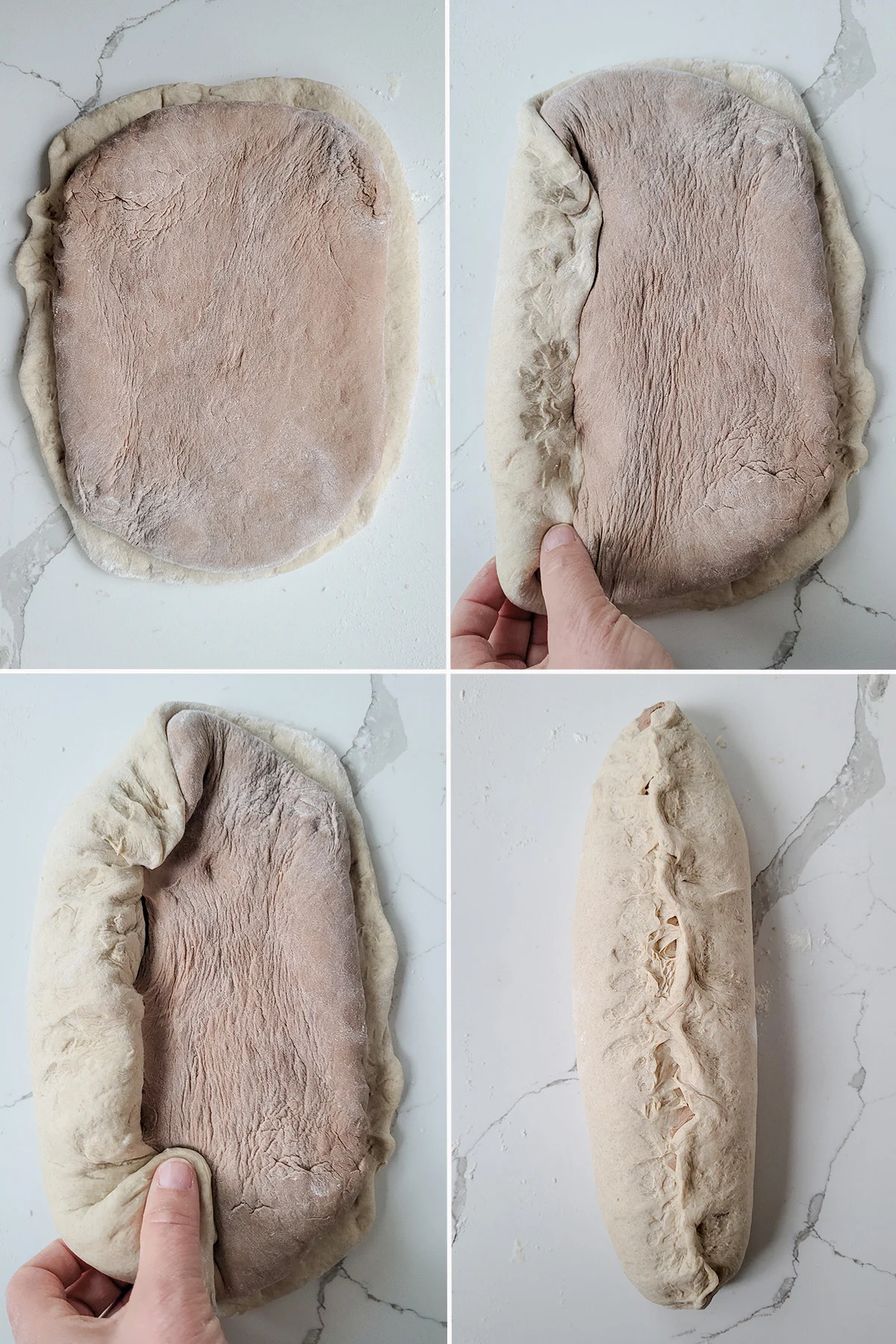
- Place the dark dough on top of the light dough.
- Roll the dough along the long side.
- Tuck in the sides as you go.
- Pinch the bottom seam and flip the loaf seam side down.
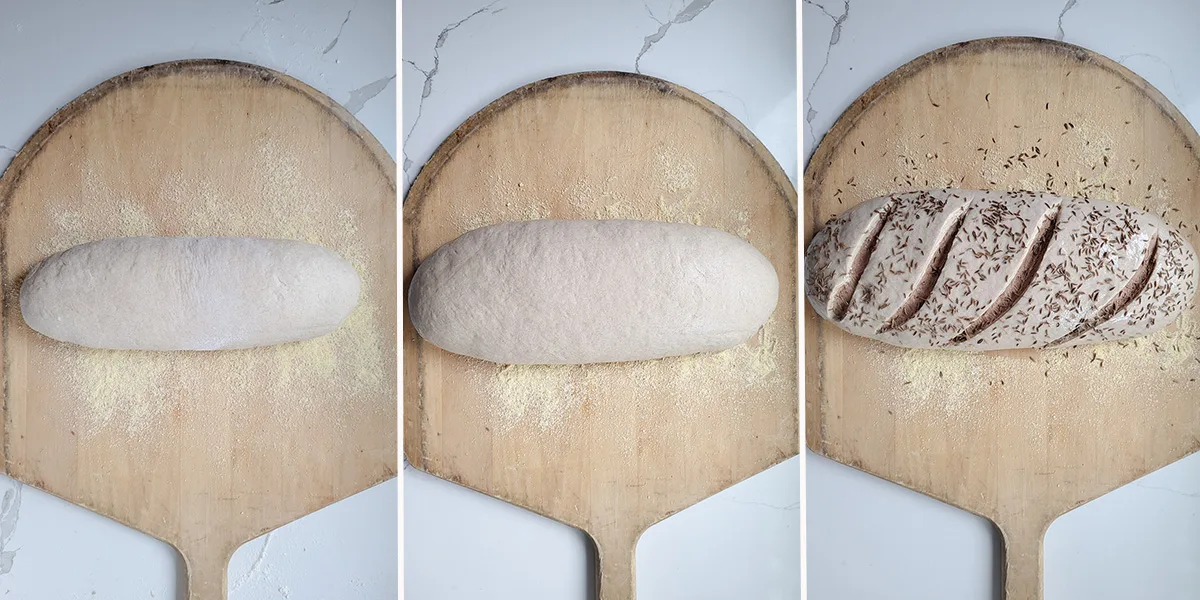
- Place the loaf on a peel or sheet pan generously sprinkled with corn meal.
- Cover with plastic wrap and set aside until the loaf has almost doubled in size and the dough springs back slowly when pressed, about 2 hours. The rising time will be longer if the dough is cold from the refrigerator.
- Make 5 slashes across the top of the loaf. Brush the loaf with egg white and sprinkle with caraway seeds. Bake until the interior temperature is 200F.
Storage
Sourdough Marble Rye Bread keeps extremely well at room temperature for 2-3 days. For longer storage slice the loaf, store the slices in a freezer bag and freeze for up to a month. Defrost or toast the bread as needed.
I know you hate to throw away that sourdough discard. Check out these recipes that use sourdough discard.
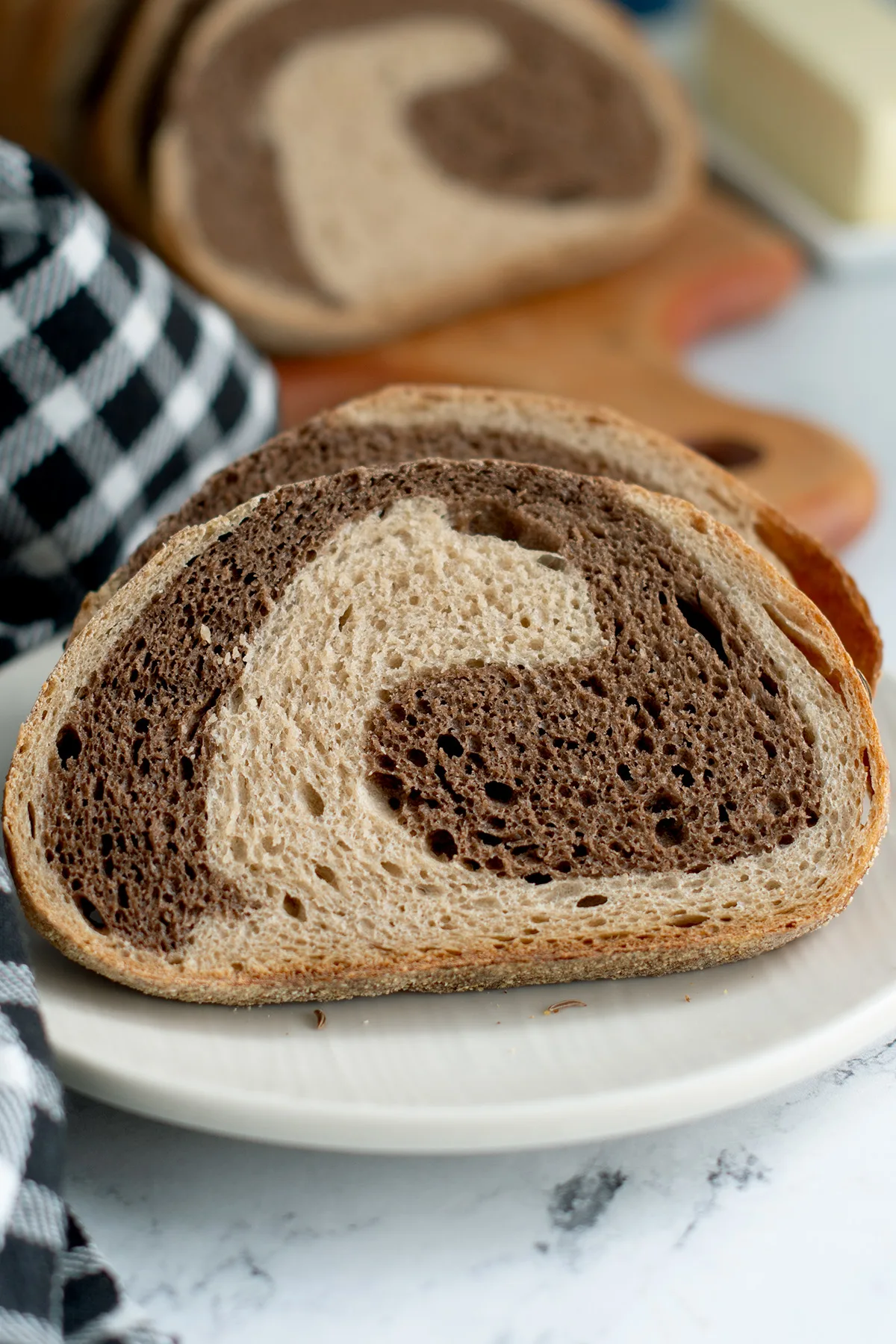
If you love this recipe as much as I do, I’d really appreciate a star rating and a quick comment. Ratings and comments help my recipes show in search results. Thanks!
Sourdough Marble Rye Bread Recipe
Ingredients
Starter
- 4 oz unfed sourdough starter (½ cup)
- 2 oz warm water (¼ cup)
- 2 ½ oz rye flour (½ cup)
Light Dough
- 6 oz warm water (¾ cup)
- 2 ½ oz rye flour (½ cup)
- 7 ½ oz bread flour (1½ cups, see note)
- ½ oz barley malt syrup (2 teaspoons, see note)
- 1 teaspoon table salt
Dark Dough
- 6 oz brewed coffee (¾ cup)
- 2 ½ oz rye flour (½ cup)
- 1 tablespoon cocoa powder
- 7 ½ oz bread flour (1 ½ cups)
- ½ oz barley malt syrup (2 teaspoons)
- 1 teaspoon table salt
- 1 egg white
Instructions
- Combine the sourdough starter, water and rye flour. Cover the bowl and let it ferment about 3-4 hours at room temperature (you can do this the night before and continue making the dough in the morning).
Make the light dough
- Combine 4 oz (1/2 cup) of the starter, 6 oz warm water, 2 ½ oz rye flour and ½ cup of the bread flour in a mixer bowl. Mix until a thick batter is formed.
- If you're using a stand mixer, switch to the dough hook. Add ½ oz barley malt syrup, 1 teaspoon table salt and the remaining bread flour. If the dough is extremely sticky sprinkle in a few more tablespoons of bread flour.
- Knead the dough on medium for 5 minutes until it begins to clear the sides of the bowl and forms a ball around the hook. Turn it out onto a lightly floured surface. If working by hand, stir in as much of the flour as you can then turn the dough out onto a floured surface and knead for 4-5 minutes.
- The dough may be a little sticky so keep your hands well floured. Place the dough into a lightly oiled bowl, turning once to coat the dough.
- Place the dough into an oiled bowl, turning once to coat. Cover and set at room temperature for 1 hour. After an hour, working from four corners of the dough (still in the bowl) use your hand to lift the top edge of the dough over into the middle of the dough. Repeat with the other 3 sides then flip the dough over. Cover and set at room temperature for another hour. Repeat the folding procedure 2 more times so the dough rises for a total of 3 hours. By now the dough should be lively, elastic and airy. If the dough is still sluggish give it another hour or two at room temperature. After the initial fermentation the dough can be refrigerated for up to 2 days before baking or you can go ahead and shape and bake the loaf.
Make the dark dough
- Combine the rest of the starter, 6 oz brewed coffee, 2 ½ oz rye flour, 1 tablespoon cocoa powder and ½ cup of the bread flour in a mixer bowl. Mix until a thick batter is formed.
- If you're using a stand mixer, switch to the dough hook. Add ½ oz barley malt syrup, 1 teaspoon table salt and the remaining bread flour. If the dough is extremely sticky sprinkle in a few more tablespoons of bread flour.
- Knead the dough on medium for 5 minutes until it begins to clear the sides of the bowl and forms a ball around the hook. Turn it out onto a lightly floured surface. If working by hand, stir in as much of the flour as you can then turn the dough out onto a floured surface and knead for 4-5 minutes.
- The dough may be a little sticky so keep your hands well floured. Place the dough into a lightly oiled bowl, turning once to coat the dough.
- Place the dough into an oiled bowl, turning once to coat. Cover and set at room temperature for 1 hour. After an hour, working from four corners of the dough (still in the bowl) use your hand to lift the top edge of the dough over into the middle of the dough. Repeat with the other 3 sides then flip the dough over. Cover and set at room temperature for another hour. Repeat the folding procedure 2 more times so the dough rises for a total of 3 hours. By now the dough should be lively, elastic and airy. If the dough is still sluggish give it another hour or two at room temperature. After the initial fermentation the dough can be refrigerated for up to 2 days before baking or you can go ahead and shape and bake the loaf.
Assemble and bake
- Turn the light dough out onto a lightly floured surface. Roll the dough into a 8" x 10" oval. Do the same with the dark dough.
- Lay the dark dough on top of the light dough then roll the dough from the long side to form a tight log. Place the loaf on a wooden peel or sheet pan sprinkled liberally with corn meal.
- Cover with plastic wrap and leave in a warm place until doubled in size, and it springs back slowly when poked, about 2-3 hours. Alternately, you can refrigerate the loaf overnight and rise and bake the next day.
- Preheat the oven to 400 °F. If you have a baking stone place it in the oven to preheat. Make 5 diagonal slashes in the dough with a single edge razor or very sharp knife. Brush the dough with egg white and sprinkle with caraway seeds, if desired. Slide the dough onto the preheated stone or slide the sheet pan into the oven.
- The bread is ready when the internal temperature of the loaf is 200 °F. Baking time is approximately 30 minutes.
- Cool completely on a wire rack before slicing.
Would you like to save this recipe?
As an Amazon Associate and member of other affiliate programs, I earn from qualifying purchases.

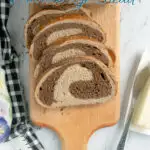
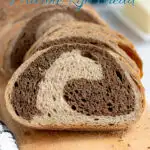
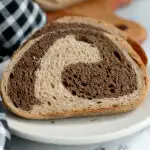




This bread is amazing: tantalizing aroma when baking, marvelous crust, great flavor. Had to do a little math as the rye starter didn’t include the metric conversions, plus I made 4 loaves, so had to multiply all the ingredients. (Calculator is a great kitchen tool!) Absolutely baking this again; thank you for sharing this wonderful recipe!
Hi Denise, thanks for the heads up about the metric conversion for the starter. It’s been fixed.
@Eileen Gray, WOW-that was fast!! thanks, again, for the great recipe 🙂
Eileen, I just started to make the starter for your Sourdough Marble Rye Bread and it is very stiff. I weighed all the ingredients exactly. Should it be this stiff and if not what can I do? Add a tad more warm water or maybe it thins out as it ferments. Thanks for your help.
Yes, the rye starter is a little stiffer than my normal starter. There’s an extra 1/2 oz of rye flour so the hydration is a little less than 100%. You can see the texture in the process photos. If you started with a 100% starter the rye starter should be stiffer than the normal starter, but not as stiff as an actual dough.
@Eileen Gray, Thanks I think my starter is ok so I will proceed with your recipe
Great! I love this bread, I hope you do too.